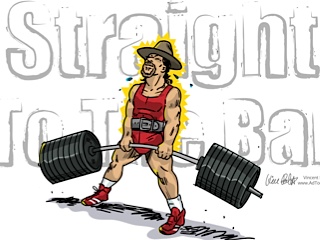Bulking.
Scott and I covered bulking in a gymchat a while back, but I do get quite a few questions about it so I want to touch on the topic once more.
Bulking up or eating to gain muscle mass is something anyone who has ever picked up a weight has come across. It basically means that you increase your caloric intake above maintenance in order to build huge, beautiful muscles to impress girls or whatever your goal is. Sounds easy enough but does it work?

There are two approaches toward bulking; one is GFH (get fucking huge), where the lifter eats everything in sight for weeks on end, gains a substantial amount of weight, some if it muscle and then diets to lose the fat.

The other one is the “lean bulk“, where people are so obsessed with losing their abs that they count every calorie in order to only build muscle. After a year, they usually haven’t gained a pound and look the same.
I am not thrilled by either approach, since they both have serious drawbacks.
The lean bulking simply doesn’t work, in order to gain muscle you ll have to gain some fat with it. That doesn’t mean you should resemble a sumo wrestler but you wont have an 8 pack either.
GFH works in order to gain muscle but does require 16+ weeks of diet in order to see those. For a natural bodybuilder, it is impossible to diet for that long without losing a substantial amount of muscle, which means your gains are limited. Someone who is chemically enhanced can go this route, since the anabolics will prevent catabolism during the diet. Then there are aesthetics and overall health. An extra 30 lbs simply doesn’t look good nor is it a great idea for your heart, liver and joints to carry so much extra weight. I have tried the GFH and, while it is fun to eat whatever you like, being 250 lbs in the NYC summer wasn’t all that great. But I digress.
SO whats left to do? I’d suggest to gain a little and then diet for a week in order to limit fat gain and keep you looking great, basically “culking“.
Lets cover some basics first. How much muscle can you gain? Despite what the magazines tell you, you will NOT gain 20 lbs of muscle in 8 weeks.
1/2 lbs per week would be outstanding, which wold come to 25lbs a year. That’s a figure that novice lifter might achieve; if you are more advanced 6-8 per year would be outstanding. As for fat gain, depending on your nutrition and genetics for every 3 lbs of muscle you will gain 1 lbs of fat, some unfortunate individuals might even gain 1 lbs of fat for every lbs of muscle gained. It’s a harsh reality isn’t it?
The next question is : how much should you eat? The traditional answer is 500 calories over maintenance, which isn’t really helpful, since it doesn’t give a macronutrient breakdown.
You’ll need anywhere from 16-20 calories per pound of bodyweight. If you are a very fidgety or nervous individual, the number might be as high as 25lbs. It isn’t uncommon for some individuals to burn as much as 800 cals/day via NEAT (non-exercises thermogenic activity) or fidgeting.
In our case, for the sake of the argument, we are looking at a 200lbs lifter, he’ll need to eat 4,000 calories a day. Fun.
Here is my idea for the macros: protein 1 gram per lbs bodyweight, you might go to 1.5 if you train more than 4 times a week or have a physically demanding job. I have gone as high as 3 grams per lbs without any real benefits, you just need to buy more protein powder. Our example will eat 200 grams of protein which covers about 800 calories.
The bulk of the calories will need to come from carbohydrates, these have gotten a bad rep in our days, which is somewhat undeserved. While it is true that the body can function without carbohydrates, it can not produce enough glucose via ketosis on order to fuel a highly an energy intensive activity such as weight lifting. 2-3 grams of carbs per lbs of bodyweight is usually a good rule of thumb, individuals with a high NEAT expenditure might go as high as 4 grams.
Lets assume 2.5 grams for our test individual, which would be 500 grams a day or 2000 calories. That leaves us with 1,200 calories for fat or about 130 grams, or.75 grams per lbs bodyweight.
Now I’ll break another taboo: overall caloric intake matters much more than nutrient sources. In other words, worry about getting the proper amounts of protein, carbs and fats in and not so much whether all your food is organic and locally farmed. If you can combine the two, more power to you. The reality is that most lifters need to add a little bit of junk in order to fill the necessary calories (my favorite: gummy bears before a leg workout). That’s ok and won’t kill you instantly.
After 4 weeks of eating in this manner, you should have gained 3 lbs or so; now it’s time to let your body breathe and minimize fat gain. In order to do so, cut the carbs in half on training days and 1-2 no carb days a week. You may up the fats to 1 gram per lbs of body weight so you stay somewhat full and don’t become a menace to society.
The low carb week will restore insulin efficiency, so that once you start eating again, the carbs will be used properly. In addition, you ll stay leaner which makes for better use of nutrients and a higher training motivation. Keep repeating that cycle for about 4-5 months, then take a 3 week break where you eat for your (new) maintenance.
After 10 months, you should have gained a decent amount of muscle without having lost sight of your feet.
There you have it, my way of bulking.
Train hard
Maik










0 Comments